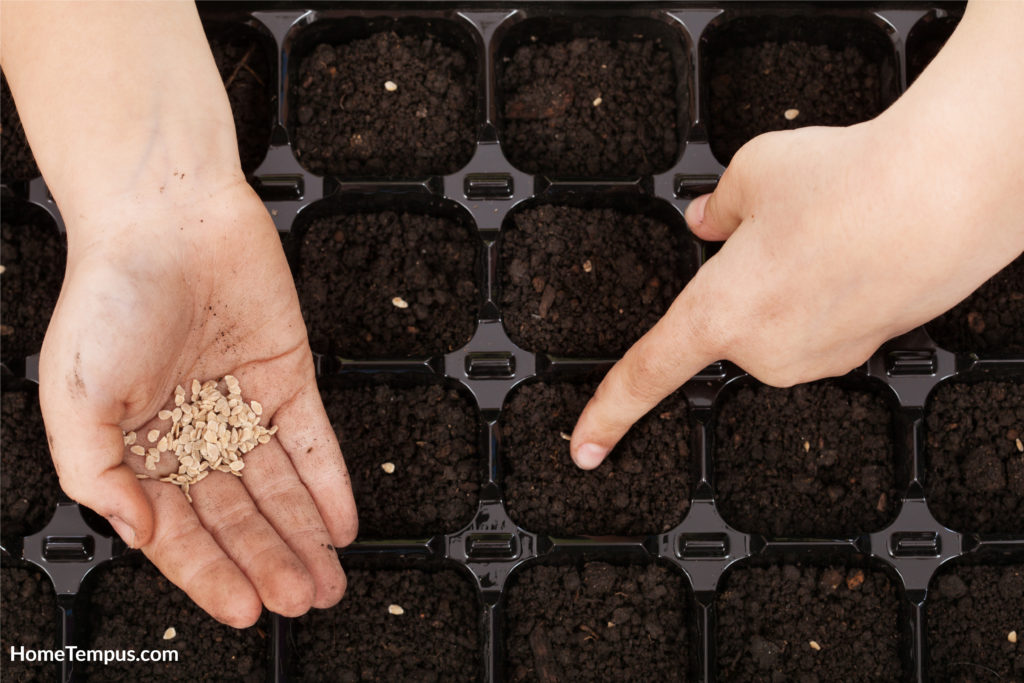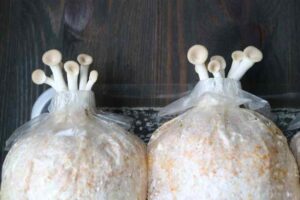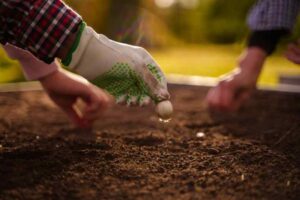
Tomatoes are a popular home garden vegetable and one of the most rewarding plants to grow. Knowing the correct number of tomato seeds to plant per hole is essential for a successful harvest.
Generally, the recommended number of tomato seeds to plant per hole is one or two, depending on the variety of tomato being grown.
This article will discuss the importance of planting the correct number of tomato seeds per hole for a healthy and successful harvest. It will cover the factors that determine the number of seeds to plant, how to determine the right number for your plants, and other important tips for successful tomato growing.
How Many Tomato Seeds Should You Plant Per Hole?
Every experienced gardener knows the significance of not overcrowding seeds in a hole. Tomato plants are no exception. Typically, it is recommended to plant 2 to 3 tomato seeds per hole. This quantity ensures a higher germination rate, increases the chances of healthy seedling growth, and reduces the risk of seed wastage.
The theory behind planting more than one seed per hole is that if one seed fails to germinate, the others may still sprout. After germination, it’s crucial to select the strongest seedling and remove the others to prevent competition for nutrients, light, and space.
Understanding Tomato Seed Packet Information
Seed packets are a goldmine of valuable information. When it comes to tomato seeds, here’s a breakdown of what you’re likely to find:
- Variety Name: Each packet will specify the type of tomato. This could be anything from ‘Cherry Tomato’ to ‘Beefsteak,’ each with unique characteristics.
- Description: This section provides information about the tomato’s taste, color, size, texture, and other distinguishing features.
- Days to Maturity: This indicates the approximate number of days from planting the seed to the time you can harvest ripe tomatoes.
- Planting Depth and Spacing: These are crucial guidelines for how deep to plant your seeds and how far apart they should be from each other.
- Sunlight Requirements: Tomatoes generally need full sun, but this section will specify the minimum number of sunlight hours your plants need each day.
- Germination Rate: This tells you the percentage of seeds that should successfully sprout under optimal conditions.
- Seed Count: This indicates the number of seeds contained within the packet.
- Packed for Year: This tells you the year for which the seeds are packed. It’s always best to use seeds within a year or two as the germination rate decreases over time.
- Planting Instructions: This section offers a brief guide on how to plant the seeds.
- Origin: This indicates where the seeds were grown and packaged.
Key Terms on Tomato Seed Packets
Some seed packets may contain terms that may be confusing. Here’s what they mean:
- Heirloom: These are open-pollinated varieties that have been passed down for generations.
- Hybrid: These seeds are the result of cross-pollinating two different varieties of tomato plants.
- Determinate or Indeterminate: Determinate tomatoes grow to a certain height and then stop, producing all their fruit at once. Indeterminate tomatoes continue to grow and produce fruit throughout the growing season.
- Organic: These seeds come from plants that have been grown without the use of synthetic fertilizers or pesticides.
Factors to Consider When Planting Tomato Seeds
Choosing to grow tomatoes from seeds can be a rewarding endeavor, as it allows a much wider variety selection than purchasing pre-grown plants. Here are key factors you need to consider when planting tomato seeds:
- Seed Variety: Choose a variety that is suited to your climate and meets your specific needs, whether that be size, taste, or disease resistance.
- Seed Quality: Buy seeds from a reputable source to ensure they are disease-free and have a high germination rate.
- Planting Time: Start your seeds indoors 6-8 weeks before the last expected frost in your area. This gives your plants a head start and ensures they are strong enough to be transplanted outdoors.
- Soil Preparation: Use a well-draining, nutrient-rich potting mix for your seedlings. The soil should be loose and free of large clumps.
- Planting Depth: Tomato seeds should be planted about 1/4 inch deep. If planted too deep, they may not germinate.
- Seed Spacing: Plant your seeds in separate containers or space them at least an inch apart if using a seed tray. This gives each seed enough room to germinate and grow.
- Temperature: The ideal temperature for tomato seed germination is around 70-80°F (21-27°C). A heat mat can help maintain this temperature if needed.
- Lighting: After germination, seedlings need plenty of light. Place them in a sunny window or use grow lights to prevent weak, leggy plants.
- Watering: Keep the soil consistently moist but not waterlogged. Overwatering can lead to damping off, a fungal disease that can kill seedlings.
- Transplanting: Once the seedlings have developed their second set of true leaves, they are ready to be transplanted to larger pots or into the garden.
Preparing Tomato Seeds for Planting
Tomato seeds can be a great way to get your vegetable garden started.
To prepare tomato seeds for planting, start by soaking them in warm water for 24 hours to soften the seed coat and encourage germination.
Once the seeds have been soaked, rinse them thoroughly in cold water to remove any debris or remaining seed coat.
After rinsing, spread the seeds out on a paper towel and allow them to dry completely.
Once dry, they are ready to be planted! With proper preparation, tomato seeds can be a great way to grow your own fresh tomatoes right in your own garden.

Planting Tomato Seeds
Planting tomato seeds successfully involves several key steps. Here’s a brief, point-by-point guide:
- Seed Selection: Choose high-quality seeds of a variety suitable for your growing conditions.
- Soil Preparation: Use a nutrient-rich, well-draining potting mix for your seeds.
- Seed Tray or Pot Preparation: Fill the pots or seed tray with the potting mix, leaving a little space at the top.
- Planting the Seeds: Make small holes in the soil about 1/4 inch deep. Place 2 to 3 seeds in each hole and cover them lightly with the soil.
- Watering: Water the seeds gently but thoroughly after planting. The soil should be moist, not soggy.
- Ideal Temperature: Place the tray or pots in a location with a temperature around 70-80°F (21-27°C).
- Proper Lighting: After germination, provide plenty of light to avoid weak, leggy seedlings.
- Thinning Seedlings: Once the seeds have sprouted, remove weaker seedlings from each hole, leaving only the strongest.
- Transplanting: When seedlings develop their second set of true leaves, they’re ready to be transplanted to larger pots or directly into the garden.
By following these steps, you’ll improve your chances of growing healthy, productive tomato plants from seeds. Happy gardening!
Caring for Tomato Seedlings
Caring for tomato seedlings is an essential step in cultivating a successful and bountiful crop of tomatoes.
- Light: Ensure your seedlings receive plenty of light to prevent them from becoming leggy. 14-16 hours of sunlight or grow light per day is recommended.
- Water: Water your seedlings regularly, but avoid overwatering. The soil should be moist, not soaked.
- Temperature: Maintain a temperature of around 65-75°F (18-24°C) for optimal growth.
- Fertilization: Once the seedlings have their first set of true leaves, begin a regular feeding schedule with a balanced, water-soluble fertilizer.
- Thinning: Remove weaker seedlings to ensure that the strongest one in each cell or pot has enough space and nutrients to grow.
- Transplanting: When seedlings have developed their second set of true leaves, they can be transplanted to larger containers.
- Hardening Off: Gradually acclimate your seedlings to outdoor conditions over a week or two before transplanting them into the garden.
- Planting Out: Transplant your hardened-off seedlings into the garden, taking care not to damage their roots. Bury them up to their first set of true leaves to encourage strong root development.
- Mulching: Use mulch around your transplanted seedlings to retain moisture and control weeds.
- Support: Install cages or stakes early on to support your plants as they grow and to keep the fruit off the ground.
Harvesting and Storing Tomatoes
Tomatoes are a delicious and versatile fruit which can be used in many dishes. Harvesting and storing tomatoes is an important part of the home gardener’s experience.This guide provides useful tips on harvesting and storing your tomatoes for maximum freshness and flavor.
Harvesting Tomatoes
- Time your harvest: Harvest tomatoes when they are fully colored and slightly firm. The exact timing will depend on the tomato variety.
- Gentle handling: When picking tomatoes, be gentle to avoid bruising them. This not only affects their aesthetics but also their storage life.
- Snip or twist off: Use a pair of clippers to cut the stem, or gently twist and pull the tomato from the vine.
- Morning harvest: If possible, harvest tomatoes in the morning after the dew has dried but before the afternoon heat.
- Green tomatoes: You can also harvest green tomatoes and allow them to ripen off the vine. This is especially useful at the end of the growing season when frost is imminent.
Storing Tomatoes
- Room Temperature: Store ripe tomatoes at room temperature if you plan to use them within a few days. Keep them out of direct sunlight and preferably stem-side down to prolong their freshness.
- Avoid Refrigeration: Avoid refrigerating tomatoes, as cold temperatures can make the tomatoes mealy and diminish their flavor. However, if your tomatoes are overripe, refrigeration can slow down the decay process.
- Freezing: For long-term storage, you can freeze tomatoes. Consider removing skins and seeds before freezing, although this isn’t essential. You can freeze them whole, sliced, or crushed.
- Canning: Another option for long-term storage is to can your tomatoes. This process involves placing tomatoes in jars and heat-treating them to kill or inhibit spoilage-causing microorganisms.
- Drying: Tomatoes can be dried using a dehydrator, oven, or even natural sunlight. Once dried, they should be stored in airtight containers in a cool, dark place.
Harvesting and storing tomatoes properly can significantly extend their shelf life and preserve their flavor. Remember, homegrown tomatoes are usually far superior to those bought from stores, so make sure to get the most out of your harvest with these tips. Happy harvesting!
FAQs About the How Many Tomato Seeds To Plant Per Hole
How many tomato seeds should I plant per hole?
Answer: Generally, you should plant only one tomato seed per hole. Planting multiple seeds per hole will result in overcrowding and poor plant growth.
How deep should I plant the tomato seeds?
Answer: Tomato seeds should be planted about 1/4 inch deep. If the soil is dry, you may need to plant the seeds slightly deeper.
How far apart should I plant the tomato seeds?
Answer: The recommended spacing between tomato plants is about 24-36 inches. Planting the seeds farther apart will give the plants more room to grow and will help prevent overcrowding.
Conclusion
It is important to consider a variety of factors when determining how many tomato seeds to plant per hole. Factors such as the size of the seed, the type of soil, and the amount of light the seed will receive all have an impact on how many seeds should be planted. Generally, it is recommended to plant two to three seeds per hole, and then thin out the seedlings as they grow. This will help to ensure the best possible tomato yield.







